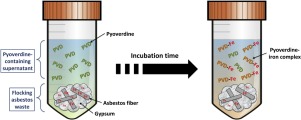当前位置:
X-MOL 学术
›
J. Hazard. Mater.
›
论文详情
Our official English website, www.x-mol.net, welcomes your
feedback! (Note: you will need to create a separate account there.)
Efficiency of pyoverdines in iron removal from flocking asbestos waste: An innovative bacterial bioremediation strategy.
Journal of Hazardous Materials ( IF 12.2 ) Pub Date : 2020-03-12 , DOI: 10.1016/j.jhazmat.2020.122532 Sébastien R David 1 , Dris Ihiawakrim 2 , Robert Regis 3 , Valérie A Geoffroy 4
Journal of Hazardous Materials ( IF 12.2 ) Pub Date : 2020-03-12 , DOI: 10.1016/j.jhazmat.2020.122532 Sébastien R David 1 , Dris Ihiawakrim 2 , Robert Regis 3 , Valérie A Geoffroy 4
Affiliation

|
The use of asbestos-containing products has been banned in many countries since the beginning of the 80's due to its carcinogenic properties. However, asbestos is widely present in private and public buildings, resulting in the need to process a vast amount of asbestos-containing waste. Among the current technologies for the destruction of asbestos fibers, biodegradation by fungi, lichens, and, more recently, bacteria has been described. We previously reported the involvement of the bacterial siderophore pyoverdine in the release of iron from the two asbestos groups, serpentines and amphiboles. Among the large diversity encountered in the pyoverdine family, we examined whether these siderophores can alter flocking asbestos waste as well. All the tested pyoverdines were efficient in chrysotile-gypsum and amosite-gypsum weathering, although some exhibited higher iron dissolution. Iron was solubilized by pyoverdines from Pseudomonas aeruginosa and mandelii in a time-dependent manner from chrysotile-gypsum within 24 h. Renewal of pyoverdine-containing supernatant every 24 or 96 h allowed iron removal from chrysotile-gypsum at each cycle, until a limit was reached after 42 days of total incubation. Moreover, the dissolution was concentration-dependent, as demonstrated for the pyoverdine of P. mandelii. Pyoverdine-asbestos weathering could therefore become an innovative method to reduce anthropogenic waste.
中文翻译:

丙酮over从植绒石棉废物中除铁的效率:一种创新的细菌生物修复策略。
自80年代初以来,由于其致癌性,许多国家禁止使用含石棉的产品。然而,石棉广泛存在于私人和公共建筑中,导致需要处理大量的含石棉废物。在用于破坏石棉纤维的当前技术中,已经描述了由真菌,地衣以及最近的细菌引起的生物降解。我们先前曾报道过细菌铁载体pyoverdine参与了两个石棉组(蛇纹石和闪石)中铁的释放。在pyoverdine家族中遇到的众多多样性中,我们研究了这些铁载体是否也可以改变植绒石棉的浪费。所有经测试的丙酮丁醚在温石棉石膏和铁石石膏风化中均有效,尽管有些表现出较高的铁溶解度。铁与铜绿假单胞菌和曼陀罗的pyoverdines在24小时内以时间依赖性方式溶解了温石棉石膏中的铁。每24或96小时更新一次含吡啶酮的上清液,可以在每个循环中从温石石膏中除铁,直到总温育42天后达到极限。此外,如P. mandelii的吡啶酮所证明的,溶解是浓度依赖性的。因此,Pyoverdine石棉的风化可以成为减少人为浪费的一种创新方法。每隔24或96小时更新一次含吡啶酮的上清液,可在每个循环中从温石石膏中除铁,直到总温育42天后达到极限。此外,如曼氏假单胞菌的pyoverdine所证明的,溶解是浓度依赖性的。因此,Pyoverdine石棉的风化可以成为减少人为浪费的一种创新方法。每隔24或96小时更新一次含吡啶酮的上清液,可在每个循环中从温石石膏中除铁,直到总温育42天后达到极限。此外,如曼氏假单胞菌的pyoverdine所证明的,溶解是浓度依赖性的。因此,Pyoverdine石棉的风化可以成为减少人为浪费的一种创新方法。
更新日期:2020-03-12
中文翻译:

丙酮over从植绒石棉废物中除铁的效率:一种创新的细菌生物修复策略。
自80年代初以来,由于其致癌性,许多国家禁止使用含石棉的产品。然而,石棉广泛存在于私人和公共建筑中,导致需要处理大量的含石棉废物。在用于破坏石棉纤维的当前技术中,已经描述了由真菌,地衣以及最近的细菌引起的生物降解。我们先前曾报道过细菌铁载体pyoverdine参与了两个石棉组(蛇纹石和闪石)中铁的释放。在pyoverdine家族中遇到的众多多样性中,我们研究了这些铁载体是否也可以改变植绒石棉的浪费。所有经测试的丙酮丁醚在温石棉石膏和铁石石膏风化中均有效,尽管有些表现出较高的铁溶解度。铁与铜绿假单胞菌和曼陀罗的pyoverdines在24小时内以时间依赖性方式溶解了温石棉石膏中的铁。每24或96小时更新一次含吡啶酮的上清液,可以在每个循环中从温石石膏中除铁,直到总温育42天后达到极限。此外,如P. mandelii的吡啶酮所证明的,溶解是浓度依赖性的。因此,Pyoverdine石棉的风化可以成为减少人为浪费的一种创新方法。每隔24或96小时更新一次含吡啶酮的上清液,可在每个循环中从温石石膏中除铁,直到总温育42天后达到极限。此外,如曼氏假单胞菌的pyoverdine所证明的,溶解是浓度依赖性的。因此,Pyoverdine石棉的风化可以成为减少人为浪费的一种创新方法。每隔24或96小时更新一次含吡啶酮的上清液,可在每个循环中从温石石膏中除铁,直到总温育42天后达到极限。此外,如曼氏假单胞菌的pyoverdine所证明的,溶解是浓度依赖性的。因此,Pyoverdine石棉的风化可以成为减少人为浪费的一种创新方法。











































 京公网安备 11010802027423号
京公网安备 11010802027423号